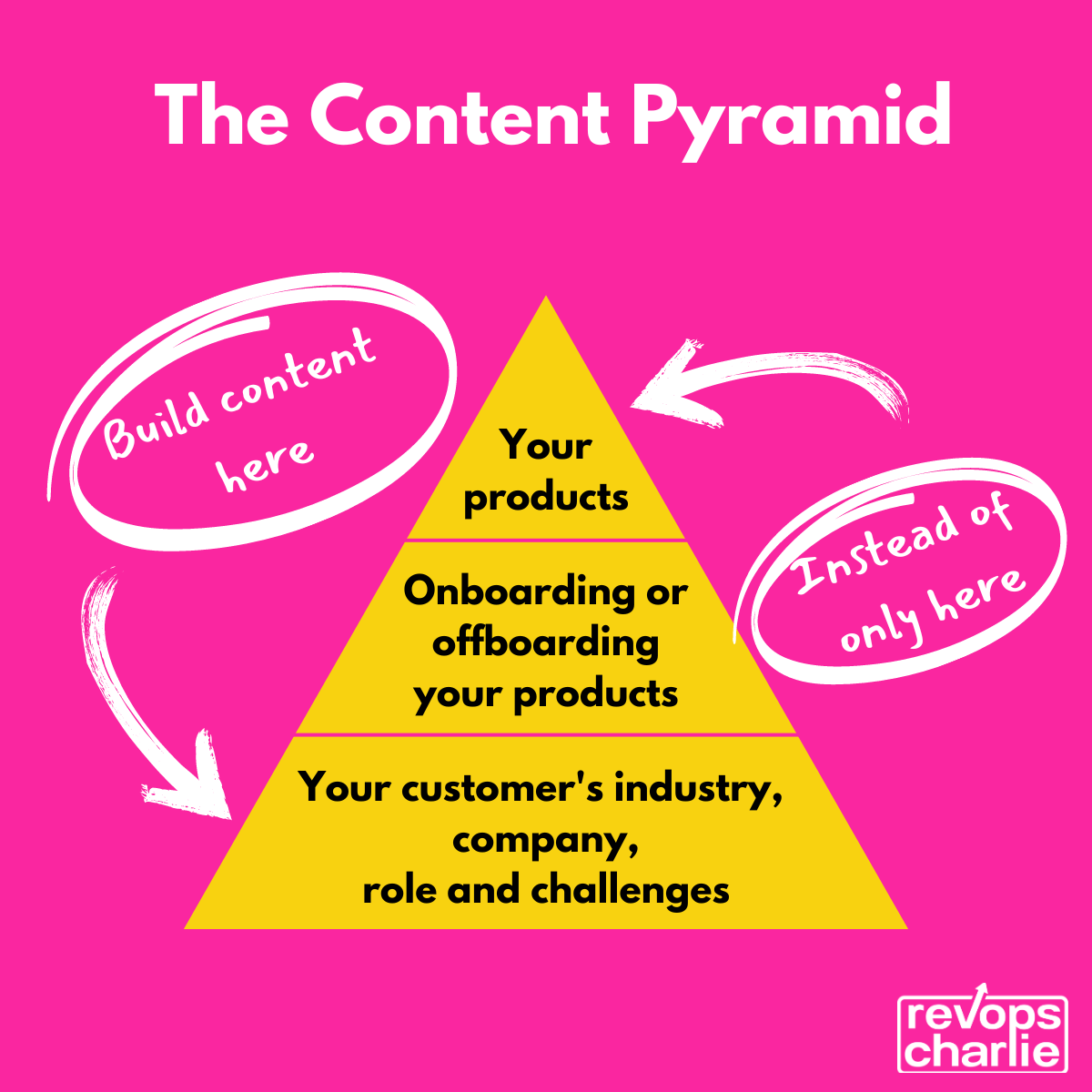Build content that buyers trust with the Content Pyramid
Most vendor content is like my singing.
Pitchy.
Even content that is dressed up to be agnostic and helpful like an ROI calculator or a customer story ends up with “And that is where the Hypersonic 2100 comes in…..”
Buyers get content blindness - and tune out the vendor content knowing that it has a not very subtle self-interest at its heart.
The Content Pyramid
Consider this content pyramid as a way of categorising the content you create.
Content related to your products
At the top you have the most common category of content.
You talk about your products and services.
You talk about your company.
You talk about the success other customers have had with your products.
You talk about the business case for buying your products.
You talk about how ‘humbled’ you are to receive the award you paid for
You you you.
At some point in the buying process your customer may need to know some of this information, but for the most part they disregard it as highly biased and not relevant to them.
Apologies to that 20 page product datasheet you just published.
Content related to onboarding or offboarding your products
The next tier down is more useful content. This is helping potential buyers peer behind the curtain and see what kind of experience they could expect if they signed the contract and became a customer.
Onboarding checklists
Roles and responsibilities
Project plan templates
Architecture diagrams
Go live processes
Admin and end user training
Offboarding processes (how to remove your product and get their data back)
This content typically comes from your CSM team (which might also encompass your onboarding, consulting and technical support teams).
This is not marketing spin - but real content that is being used by real project teams to roll out real use cases.
Not only is it valuable for your buyer, but it also opens up a new line of discussion with your onboarding and CSM teams as the opportunity moves into its negotiating and closing stages.
Don’t hide this until the customer signs - give them access now and it will reduce the risk of deals slipping or closing no decision.
Content related to your customer’s industry, company, role and challenges
Finally we have the most valuable set of content you can create.
Imagine a world where your company and products didn’t exist.
I know - painful - but stick with it.
How would you advise your buyer if your company wasn’t an option?
How would you help them to determine the opportunities in front of them?
How would you help them evaluate the cost of the problems they are facing?
How could they solve the problems using the technology they have today?
What process changes could they make?
What other technology or consulting partners would you recommend?
Who would you suggest they speak to?
What events or networks would you recommend they join?
Which other industries are a useful comparable for them to learn from?
These questions help you really get into the mind of your customer and provide advice that can really help them.
These are not questions that ChatGPT or your marketing intern can answer for you.
You need to interview your top CSMs, your top consultants, your C-Suite, your System Integrator partners, your analysts.
Out of these questions you will create checklists, benchmarking tools, marketplace assessments, diagnostic tools and partner content that buyers can actually use to better understand the world they live in.
Focus on helping your buyer not pitching your product
I’m not suggesting you don’t need product content - you will later in the buying process.
I am suggesting that the right starting point for your content strategy is a world in which the answer is not always the Hypersonic 2100 (or whichever product you are selling).
As you build out your content roadmap, add a column to your spreadsheet that defines these three categories, and ensure that at least half of your content is valuable to your buyer and not just a subtle (or not subtle) attempt at pitching your products.
Get started
Whenever you are ready, there are three ways that I can help you accelerate your revenue.
Buyer Experience Audit - I’ll impersonate a buyer researching your segment and company and let you know what I find. Ideal for planning your Revenue Operations strategy.
Business Model Design Workshops - I’ll work with you and your team to design or refine a business model for a new or existing product.
RevOps Impact Playbooks - I’ll help you implement one or more tactical processes across your revenue teams - content, referrals, testimonials, adoption and more.


